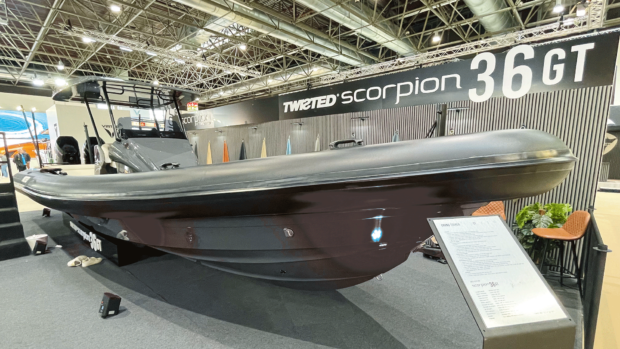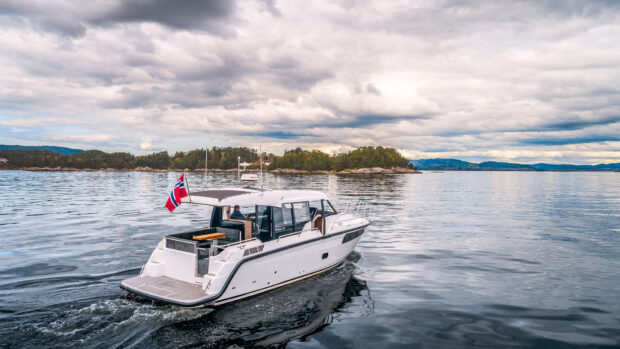Forget the three musketeers, these new All-in-One stabilisers claim to do the job of fins, gyros and trim tabs in one convenient package
he logic behind DMS Holland’s new All-in-One stabilisers is as simple as it is compelling – why fit three different kinds of hull controls to a boat when you can have one system that does it all? According to its Dutch designers, these strange looking new wing stabilisers will combine the best features of conventional fins, gyros and interceptor trim tabs without the drawbacks sometimes associated with them such as long spool up times, increased fuel consumption and paddle effect at anchor.
The key to All-in-One’s versatility is a pair of long, thin high-aspect ratio fins fitted to the stern of the boat that rotate around two different axes. This allows them to swivel up and down like conventional stabiliser fins but also to flap like a pair of giant bird wings. As well as generating more stabilising force at rest than traditional rotating fins, this enables them to swing all the way round behind the transom at higher speeds to reduce drag and act like a set of oversized automatic trim tabs.

DMS Holland’s new All-in-One fins flap up and down as well as rotate, for superior stabilisation at anchor and under way
Flapping wings
In essence this gives them three different operating modes. At rest the fins will be fully extended at a slight downward angle, pointing towards the roll centre of the boat, and use the flapping motion to counteract any roll.
This flapping motion and the extra leverage of the wing tips being so much further from the roll centre than conventional fins mean even a relatively small movement will generate a powerful righting force – enough, claims DMS Holland, to make them as effective as a gyro stabiliser at anchor.
At displacement and semi-displacement cruising speeds of up to around 15 knots, the wings will stay extended but rather than flapping, they will rotate like conventional fins, using the pressure of water flowing over them to create lift or downforce in order to counteract roll. Once again, DMS claims this makes them as effective as fin stabilisers in cruising mode.
Article continues below…

New Cauldwell outboard motor: Petrol performance & diesel reliability?

Toy of the Month: Sit-down foiler yours for $89,000
Energy efficient
Lastly, at planing speeds of 16 knots or more the fins will swing all the way round and tuck in behind the trailing edge of the transom, where trim tabs normally sit.
However, being so much larger and faster acting than normal tabs, they will not only control the constant trim angle but also actively manage roll, pitch and yaw as the craft climbs over each wave.
The idea for DMS Holland’s the All-in One system was first mooted almost six years ago when the company released early renderings of the concept but only now, after extensive development and testing of a prototype model, has it committed to series production.
The first boat fitted with the new All-in-One ‘wings’ will be a 50ft planing aluminium cruiser called a Van Den Hoven Voyager 50, although discussions are underway with a potential retrofit customer and a number of other new-build manufacturers. As well as the simplicity of a single system that works equally well across the full range of speeds, it also saves on both space and installation costs.

The torpedo- shaped housing is designed to nestle into a recess on the hull chines
Counting the cost
Other claimed benefits include a reduction in drag, as the high aspect ratio shape is not only more efficient at generating lift (hence the reason glider wings are long and thin) but the surface area can be smaller too because the flapping motion is so much more effective. The fins for the Voyager 50, for example, will have a total surface area of 0.32m2 compared to around 0.8m2 for conventional fins.
This also means they draw less electrical power, around half that of conventional fins, which could prove invaluable for boats wanting to use stabilisers overnight without the generator running. And because they are mounted outside the hull right at the back of the boat, they should be quieter too.
It’s not all one-way traffic though. Being longer than regular fins and mounted closer to the bathing platform, they may pose more of a threat to swimmers. The unusual torpedo-like shape of the dual axis motors also means the hull has to be modified to fit them – easy enough for aluminium new builds like the Van den Hoven but more difficult for GRP production hulls, which may need blanks adding to the moulds, and retrofits.
And while DMS Holland hasn’t confirmed pricing yet, the All-in-One system is likely to be more expensive than conventional stabilisers (albeit cheaper than fitting fins, interceptors and a gyro).
Both the housing and the fins are made of aluminium and each complete unit weighs around 250kg. In its current format, they are suitable for boats in the 15-30m range, but larger and smaller versions are likely to follow. Being transom mounted they won’t be suitable for sterndrive or outboard powered craft but should work well with both conventional shaft and IPS pods. It’s an intriguing prospect but if it works as well in practice as it sounds on paper, it could be a game-changer.
 If you enjoyed this….
If you enjoyed this….
Motor Boat & Yachting is the world’s leading magazine for Motoryacht enthusiasts. Every month we have inspirational adventures and practical features to help you realise your sailing dreams, as well as tests and news of all the latest motorboats.
Plus you’ll get our quarterly Custom Yachting supplement where we share the last on offer in the superyacht world and at the luxury end of the market.
Build your knowledge with a subscription delivered to your door. See our latest offers and save at least 30% off the cover price.



 If you enjoyed this….
If you enjoyed this….





